
Back in March, I wrote about how the systemic console could be used to locate a tentative second planet orbiting 51 Peg. The power in the residuals periodogram, and an extensive Monte-Carlo analysis show strong evidence for a Saturn-mass world in a habitable-zone orbit. I was thus quite excited on Saturday when the California-Carnegie group released a heavy-hitting catalog paper that includes (among many other interesting things) 256 re-analyzed Lick Observatory velocities for 51 Peg. These velocity data points are of high quality, with generally small errors.
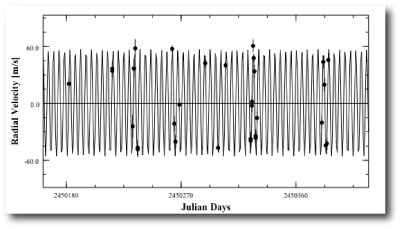
After using the console to fit out 51 Peg b, the residuals periodogram for all the data still shows a strong secondary peak. The period has shifted, however, to 345 days, and the relative power has declined somewhat with the addition of the new Lick data:
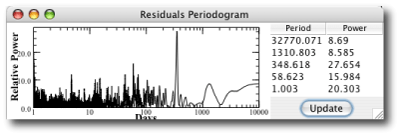
When the residuals are folded at a 345 day period, there’s a visible hint of periodicity:
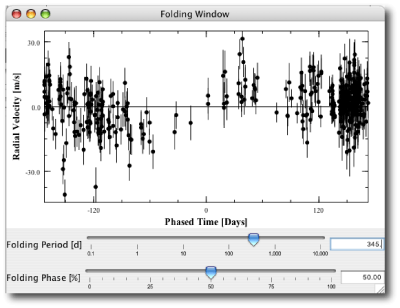
Note, however, that there are a huge number of points in the right-hand part of the diagram. These are primarily points taken at Lick during the Fall of 1995, just after the Swiss discovery announcement. There’s a scarcity of points near the middle of the diagram resulting from the near-match between 345 days and one year. The star can’t be observed when it’s near the Sun in the sky.
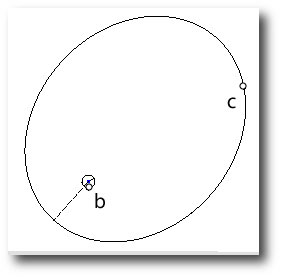
Using the console to get a 2-planet fit, the preferred mass of “c” is still about a Saturn mass, but the eccentricity has increased to e=0.59. This is a worrisome development. The system is still perfectly stable, and an eccentricity of 0.59 is certainly within the range exhibited by exoplanets. The problem is that the fit has adjusted itself so that the pronounced radial velocity swings of the outer planet tend to occur where there is no data.
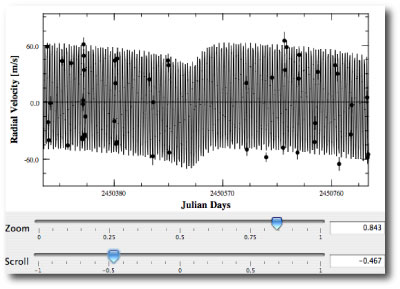
The Lick data therefore seem to have taken some of the air out of 51 Peg c. It would be good to see whether there’s any hint at all of planet “c” if we consider just the Lick velocities. This is easy to do. Just delete the line containing “51peg_ELODIE04.vels” from the 51peg_B06L.sys file in the datafiles directory that comes with the downloadable console.
Don’t worry if you screw something up. You can toss out a busted console and download a fresh one because they’re free! The only problem with downloading a lot of consoles is that the Internet is not something you just dump something on. It’s not a truck. It’s a series of tubes. And if you don’t understand those tubes can be filled, and if they are filled, when you try to get your new console out, it gets in line and its going to be delayed by anyone that puts into that tube enormous amounts of Internets, enormous numbers of consoles.
When one looks at the Lick data set by itself, the one-planet fit has a required jitter of only 3.6 m/s. This is pretty well in line with the level of astrophysical non-planet noise that would be expected from a star like 51 Peg. There’s really nothing in the Lick-only data to suggest that the model needs a second planet. The strong 350-day residual periodicity is thus present in the Swiss data, but not in the Lick data. In particular, the residuals periodogram to the one-planet fit shows absolutely nothing of interest near 350 days
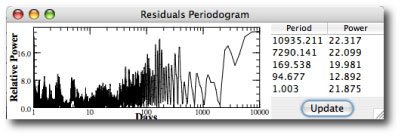
In my post from last March, I wrote that:
It could very well be true that the 356. day periodicity is due to a systematic effect in the data that has nothing to do with a planet. I would not be surprised at all if this is the real explanation. That is, the observational results might be subject to a small seasonally dependent effect produced by the telescope — as a straw-man example, the temperature of the instrument might have a slight effect on the measured radial velocity. The variation could also have an astrophysical source that has nothing to do with a second planet.
The latest data release from the Lick group certainly seems to favor this conclusion. A telescope-dependent effect is highly unlikely to be present in two independent data sets. The fact that the periodicity is present in only one set of data points toward and Earth-based, rather than a 51 Peg c-based explanation for the periodicity. In the older post, I also wrote that:
As a working scientist, I’ve found that about 95 to 97% of the seemingly publishable “discoveries” that I stumble across end up being spurious for one reason or another. Hope springs eternal, but it always pays to temper one’s enthusiasm!
Continues to be true.

Talking of modifying the data sets, I (fairly arbitrarily) threw out the first 14 data points in 55cancri_1.vels. Interesting what happens to the residuals: 55 Cancri e disappears and is replaced by a 390-day planet.
I completely agree with your conclusion that 51 Peg c is almost certainly a spurious result. However, the idea brings up a concept that I hope you would discuss in future posts.
There are statistical probabilities that can be associated with fitting (radial velocity) data. Adding another planet (equivalent to adding 7 parameters to the fit) should significantly reduce the chi-square. ** The goal of RV fitting (with the console or otherwise) is to find the smallest value of (reduced) chi-square possible for a particular data-set. ** If there exists a fit with a chi-squared of 2 or 3, then solutions that have chi-squared of 4 or 5 remain in the realm of possibility: future data may justify these fits. However, a solution that has a chi-squared of 20 or 50 is extremely less likely to be correct that a solution with chi-squared or 2 or 3.
Furthermore, adding another planet can be statistically justified. The Monte Carlo method described in post 61 is one excellent way. Another way is to use an “F-test”, where two different solutions with different chi-squares and different numbers of planets can be compared. To get a statistically significant improvement, an additional planet is only justified if the chi-square is reduced by quite a bit. Even a reduction of the reduced chi-square by 5 may not be enough to justify the addition of all those new parameters we’re fitting with the console. This is because adding parameters will always have the tendency of improving the fit. Theoretically, any RV curve could be virtually perfectly modeled by ~100 planets of all the right size, phase, and orientation, but these are not justified if a 1-planet fit has a reduced chi-squared near 1 (especially given the natural error induced by stellar jitter).
Perhaps I have gone on too long. Maybe all the blog readers know more about chi-squared than I do, but those who use the console should know their ultimate goal: find a fit to RV data with the fewest planets and the lowest chi-square possible. A fit that is lower than the chi-square reported in the planet discovery paper is interesting, especially if the planetary parameters are different than those proposed, but often not if an additional planet is required.